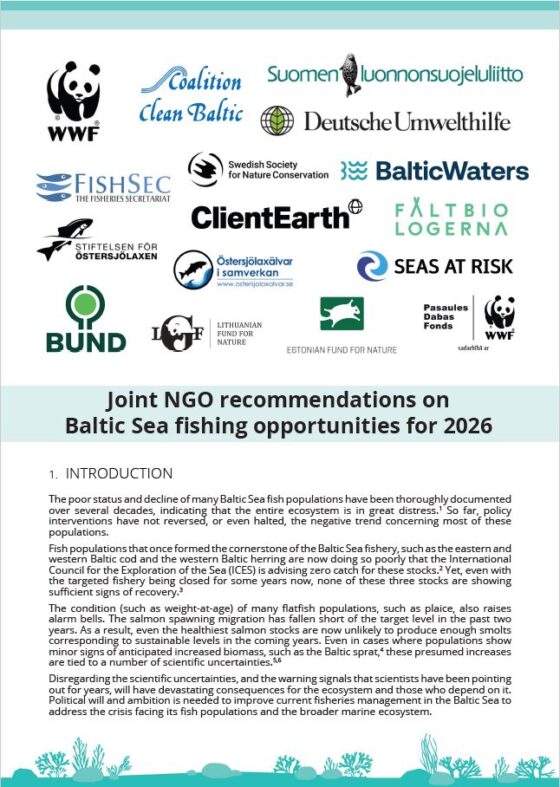State of the stocks
The Baltic ecosystem is fairly simple when it comes to commercially exploited fish. While flounder, plaice and salmon make up a portion of the commercial annual catch, the most lucrative fisheries have traditionally been for cod, herring and sprat. Today, the Baltic Sea ecosystem is in severe distress and its major commercial fish stocks have never been in a worse condition.

Read more in our latest briefing on the status of Baltic fish stocks and quota recommendations for 2026.
For decades, the large Eastern cod stock in the Baltic Sea declined dramatically. In addition to historical overfishing, unauthorised discards of unwanted cod have continued, despite the discard ban in place. In addition, parts of the stock has been affected by lack of prey, parasites and oxygen-depleted sea beds. The number of cod in the Western Baltic Sea has also dwindled to the point that the stock is on the brink of collapse.
The fisheries are in danger. At its peak in 1984, fishers landed more than 440,000 tonnes of Eastern Baltic cod. Today, the targeted fishery for cod in the Baltic Sea is closed and three of the four Baltic Sea herring stocks (central Baltic Sea excluding the Gulf of Riga, Bothnian herring and Western Baltic herring) are also in poor shape.
Occasional inflows of saline, oxygen rich seawater from the North Sea temporarily boost stock productivity. However, these inflows are not sufficient to replenish the cod stocks. Poor fishing practices coupled with eutrophication, fed by agricultural runoff, as well as pollution and temperature changes, have put the Baltic ecosystem in jeopardy.
As the cod declined, pelagic species (sprat and herring) came to dominate the Baltic fisheries. Harvests of sprat, for example, increased from a low of around 50,000 tonnes in the early 1980s to an average of 290,000 tonnes in 2018–2022. Much of the pelagic catch is processed for industrial uses and animal feed.
Properly setting limits for all Baltic stocks is vital to allow populations under pressure to bounce back, helping maintain ecosystem biodiversity, generate employment in coastal communities, and provide local food for human consumption. Policy and regulations play a key role in protecting Baltic fisheries. FishSec is working with the fishing sector and policy makers to improve long-term sustainability and move towards more ecosystem-based management. We recommend setting fishing limits according to scientific advice and support low-impact fishing methods, another critical step toward sustainability.
Last updated: June 17, 2025
Recent publications
Recommendations to the EU on the setting of fishing opportunities for ...
September 15, 2023
The 19 NGO signatories of this document wish to present our recommendations on the setting of fishing opportunities for 2024,...
Policy Brief on eel management in the Med
September 1, 2023
Europe’s eel population has declined dramatically since the 1960-1979 reference period and recruitment is now very low. The Mediterranean region...
Joint NGO recommendations on Baltic Sea fishing opportunities for 2024
June 19, 2023
The Baltic Sea ecosystem is in severe distress and the major commercial fish stocks have never been in worse condition. In...
Joint NGO recommendations on Baltic Sea fishing opportunities for 2023
June 15, 2022
In October 2022, EU fisheries ministers will agree on fishing opportunities in the Baltic Sea for 2023. As the deadline to...